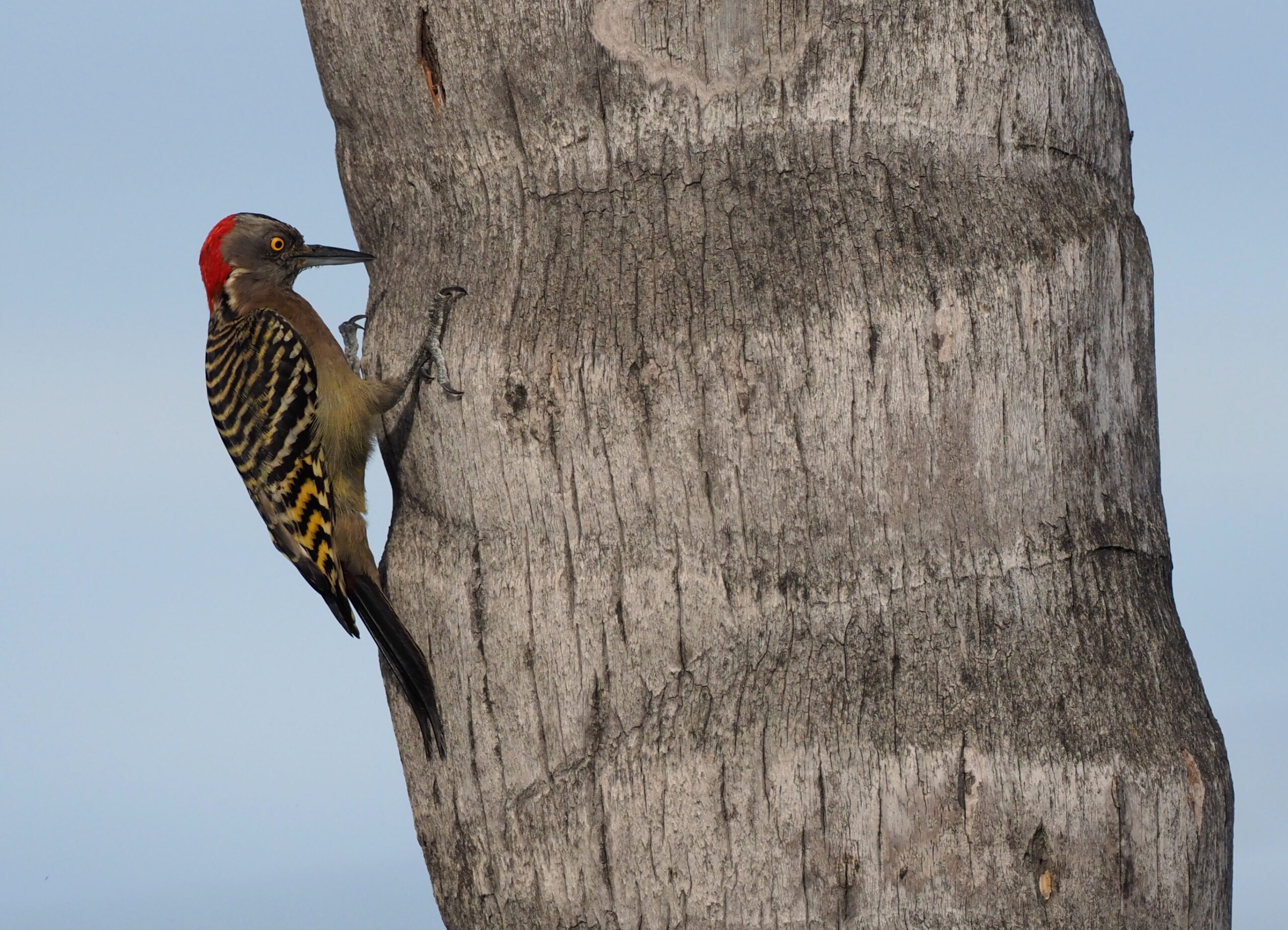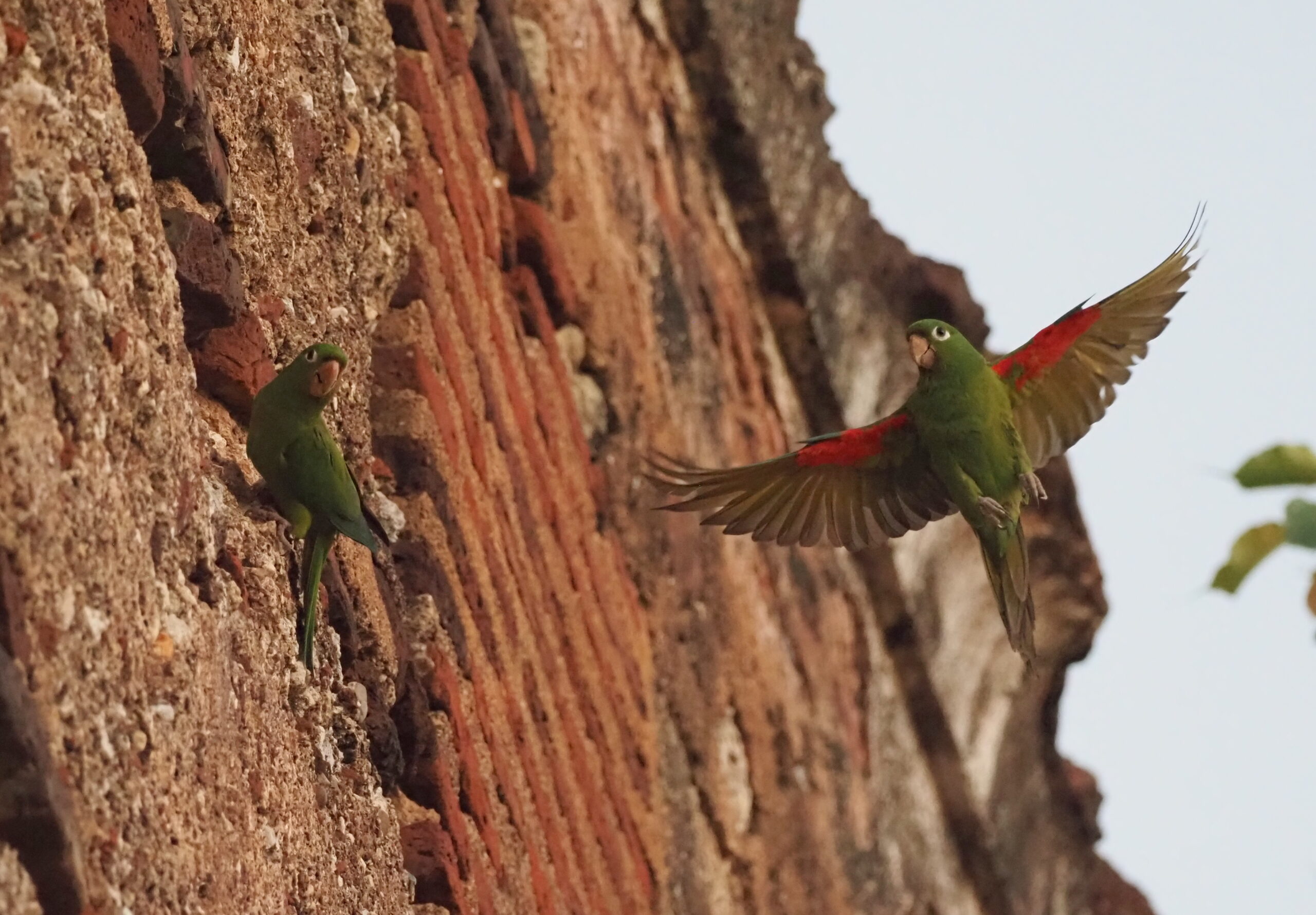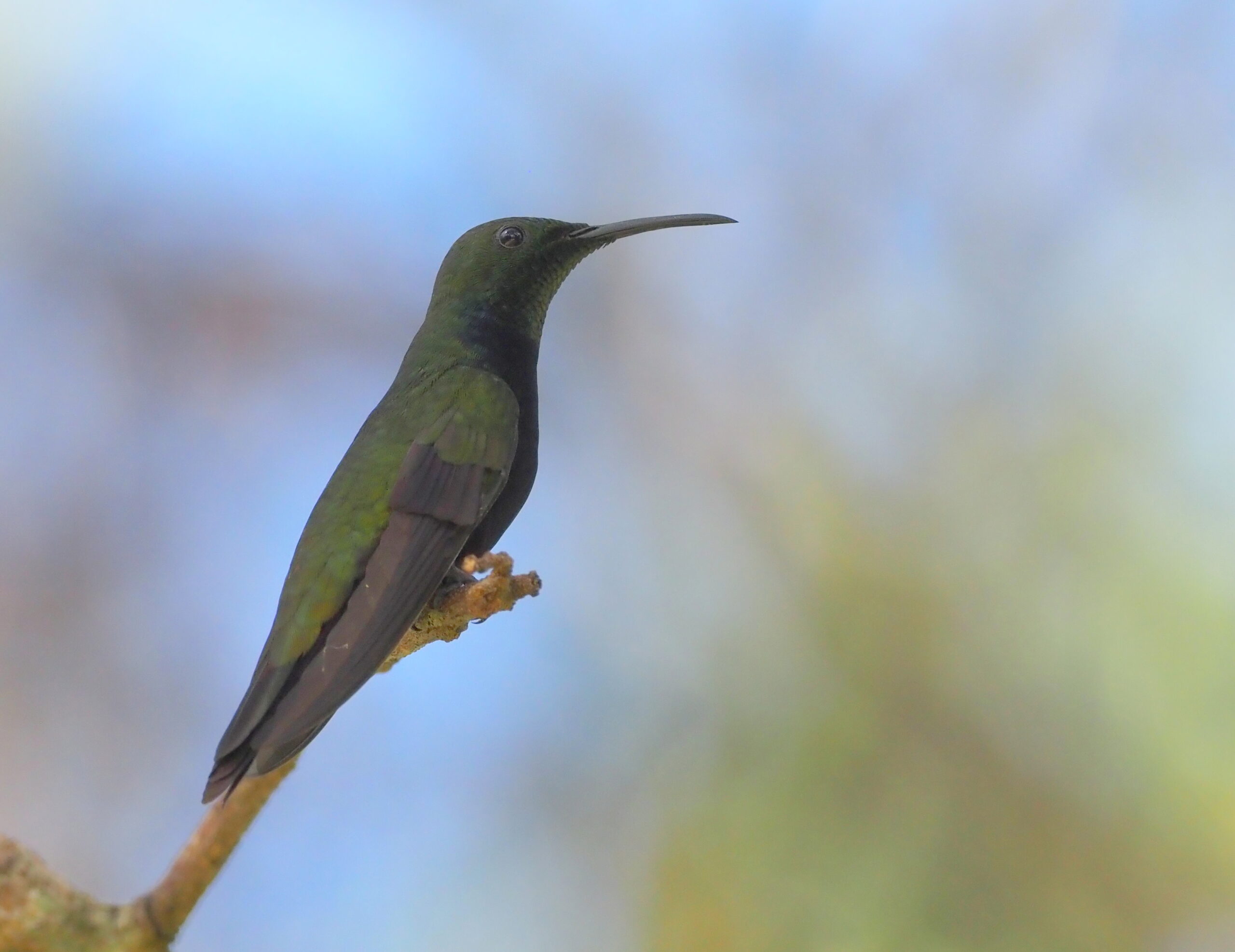
March 17-25, 2022
Narrative and Photos by Simon Thompson
What a shock! After almost 2 years in the northern hemisphere it was great to be on my first tropical trip in what seems like forever- I am sure it was the same for all of us.

We all met at the hotel in Santo Domingo which was right on a very rocky waterfront- very pleasant with a strong onshore breeze. A nearby park produced our first of Hispaniola’s 32 or so endemics: Hispaniolan Woodpecker and Palmchat were both surprisingly easy to find and ended up being everyday birds.
The next morning we were up early and rearing to go with our first official birding spot being Hospital San Nicolas de Bari (the first church in the New World). This is the go-to spot for the endemic Hispaniolan Parakeet which was very easy to see as they went in and out of the holes and crevices in the old building.



Our destination after that was Los Haitises National Park, a large park of over 300 square miles of forest, karst limestone crags and mangrove swamps. A boat trip through the mangroves was first on the agenda and a great introduction to the park.



The target bird was the rare, but increasing, West Indian Whistling-Duck and we finished the boat trip with over 20 individuals that were very easy to see as they perched on mangrove roots alongside the boat. Several Magnificent Frigatebirds were circling over the bay and we eventually got good views of Cave Swallows in their breeding cave, along with several petroglyphs left from the Taino Indian era in the 1500’s.


A long hike through the fields and forest edges produced a nice selection of Hispaniolan endemics, including: Hispaniolan Lizard-Cuckoo, Broad-billed Tody, Hispaniolan Pewee and Black-crowned Ant-Tanager – some of these we would see most days in the appropriate habitat.


Palmchats are fascinating birds that nest colonially and are a common sight through the island.

They always seem to be on the move, carrying or moving twigs around their large nests, which are also nesting sites for many other species of island birds (including the endemic Ridgway’s Hawk).
An evening excursion was successful for the stake-out Ashy-faced Owl; one of the island’s 30+ endemics- even though he was trying to hide in the top of a dead palm tree!

A long walk through the same habitat the next morning was very enjoyable, especially watching the antics of the critically-endangered Ridgway’s Hawk. Thankfully, with help from the Peregrine Fund, these birds are starting to increase their numbers and we were very lucky to be able to watch a pair at an active nest. Other birds on the walk included: Ruddy Quail-Dove, all three native hummingbirds, and the very cute Antillean Piculet – another Hispaniolan endemic. After lunch at Sabana de la Mer at a very enjoyable restaurant we returned to Santo Domingo on our way to the southwest of the island. Dinner and our night were in the colonial district of SD, which was busy and noisy. Despite that, we enjoyed a walk around the neighborhoods enjoying the classic architecture before eating at the hotel and retiring to bed.
Our first stop the next morning was some coastal wetlands near the town of Bani. These salt-pans gave us our first shorebirds and herons, plus a few migrants, such as Prairie, Parula and Black-and-white Warblers.


A Clapper Rail (Caribbean race) showed extremely well in the mangroves and a small flock of White-cheeked Pintail fed in the shallows.


The larger saltpans were also full of shorebirds; mostly Black-necked Stilt, Stilt Sandpiper, both Greater and Lesser Yellowlegs and a few Black-bellied Plover. A flock of Greater Flamingos flew over but we could never relocate them in the bay. By mid-day it was quite hot, so we had lunch (and a cold drink) at Fidel’s sandwich shop in Barahona before driving into some fascinating arid habitat to look for (and find) the Hispaniolan Palm Crow. That’s the beauty of local knowledge as we drove directly to a spot where 4 crows were calling and flying around – and yes, these were only ones of the trip! A pair of the also endemic Black-crowned Palm-Tanagers was also obvious in the spiny cactus-ridden habitat (a fascinating place botanically).
After some lowland birding we were planning to bird in the western highlands for the next few days. These high-elevation forests are home to an exciting selection of mostly-endemic birds. The first of our early mornings found us driving up terrible roads in our 4 x 4 vehicles to the wet, dripping forests of Monumento Natural Miguel Domingo Fuerte. These beautiful forests showed us our first Narrow-billed Tody (the species found at higher elevations), Hispaniolan Trogon, Eastern Chat-Tanager and Hispaniolan Spindalis.


Also several wintering wood-warblers included Ovenbird, Cape May Warbler and American Redstart. All 3 hummingbirds were quite easy to see and Bananaquits were ubiquitous.
After a picnic lunch we descended the tortuous roads back to Barahona for an afternoon walking the trails at Rabo de Gato.

This easy trail snakes through Caribbean forest along the banks of a mostly dry river. It seems as if a lot of places are drier than they used to be and as a result the birdlife is not as abundant. Our quest was the three species of Quail-Dove which occur in these forests, but we only found the Ruddy today, along with Zenaida Dove, good numbers of Hispaniolan Parrots, a pair of Antillean Euphonias and our only Flat-billed Vireo of the tour.
We stayed at the same hotel in Duverge for the next few days, which allowed us to unpack and relax a little more than it would have been moving every day. However, the town was having water and electricity issues during our stay, which resulted in outages on a daily basis! Thankfully the restaurant in town was consistent with the food being pretty good overall and we could enjoy a cold beer at the same time.
It was another early morning but today we were driving higher into the mountains to Zapoten and the Parque Nacional Sierra de Bahoruco. We started well before dawn and managed excellent views of the Greater Antillean Nightjar on our way up. Yes, the roads had to be some of the worst I have ever been on and there was little chance of having a nap on the way up the mountains. Thankfully we had some very capable drivers who navigated the road/river bed very capably, although I don’t think that their cars would last too long doing this type of off-road driving on a regular basis!

The list of possible birds at Zapoten is mouth-watering and we were lucky enough to see most, if not all of them – Bicknell’s and La Selle Thrushes, Golden Swallow, Rufous-throated Solitaire, Western Chat-Tanager, Hispaniolan Crossbill, and White-winged and Green-tailed Warblers.
It really was a wonderful morning. Again we had a picnic lunch atop the mountain, before meandering our way down with a stop on the Haitian border to see the environmental devastation on that side of the border; very depressing indeed. We stopped again on the way down to find another one of our target birds – the Bay-breasted Cuckoo. This huge bird is very hard to find, but has one of the most unusual of all bird sounds. It’s best described as a harsh whining sound that’s almost comical. I need this as my phone ring tone one day!
Anyway, after one vehicle stopped for a Key West Quail-Dove, again thanks to local knowledge, we managed to track down the elusive aforementioned cuckoo. For such a big bird this tough bird knows how to conceal itself in the dense vegetation, but we managed pretty good views and even a couple of fairly average photographs.

We spent the evening on the access road to the national park waiting for dusk and the sounds of the Least Pauraque. A Burrowing Owl showed beautifully atop a roadside post and a Limpkin called from a seemingly dry environment. We did hear the Pauraques and managed scope views of one perched on a thorn bush, but nothing like the views we had of this morning’s nightjar.
We spent our last full day in the west working the lower elevations. We started with great views of a Mangrove Cuckoo before heading to an agricultural area. Before this morning we had not seen any Antillean Siskins and it seemed as if they were all waiting for us at the farm! The fields were full of them feeding on the seeds and drinking from the puddles – our last endemic of the tour.


We also added Plain Pigeon, Palm Warbler and some lesser fare before heading back to Rabo de Gato to try again for our missing Quail-Dove. Alas it was not to be and the White-fronted Quail-Dove eluded us once again.
We spent our last day slowly heading back to Santo Domingo with a morning stop at Laguna Cabral. Access was a little challenging, but we managed to find a good patch of lakeshore where we added Blue-winged Teal, American Coot and Common Gallinule. We finished the tour with 122 species for the group total and all but one of the endemics. It was a great week on Hispaniola and thanks to Manny, Efrain and all his crew of helpers, drivers etc. in making our stay so enjoyable.
More Birds…










Simon Thompson

